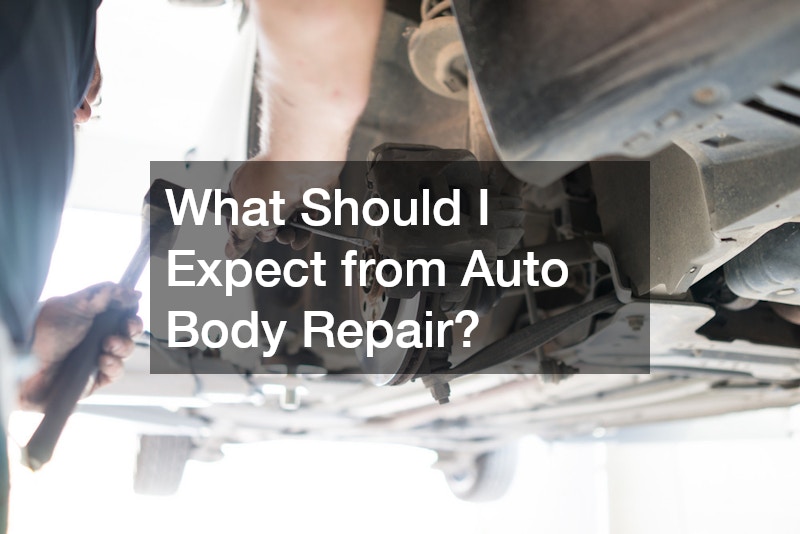
If your vehicle has been involved in an accident or endured damage from harsh weather, auto body repair is essential to restoring its appearance and functionality. Auto body repair covers a range of services that mend the vehicle's bodywork after such damage, whether cosmetic or structural. Expect to dive into a process that not only repairs dents, scratches, and broken parts but also enhances your car's resale value and safety features.
Video Source
This article is designed to walk you through what to anticipate when you visit an auto body repair shop. From initial assessments to the delivery of your rejuvenated vehicle, understanding this process can alleviate any anxiety related to the task.
The initial phase of any auto body repair process involves a thorough assessment of the damage sustained by your vehicle. Technicians will meticulously examine the impacted areas, noting both obvious and subtle forms of damage. This comprehensive inspection helps determine the scope of repairs needed and establishes a foundation for the cost estimation process. A detailed and transparent estimate will be provided, outlining the expected repairs along with the associated costs. It's crucial to understand this estimate as it sets expectations regarding both the time frame and financial commitment required for your vehicle's repair.
During this phase, you will interact directly with the service advisor or estimator who will explain the documentation and insurance claim process. The estimator may highlight additional internal or hidden damage that might only be identifiable once repair work begins. While it's crucial to trust the expertise of the technicians, don't hesitate to ask questions about any part of the assessment or estimate. Knowing what to expect financially and logistically helps avoid surprises down the line. Make sure to review and comprehend all details in the estimate report before moving forward to the repair stage.
After assessing the damage, the auto body repair shop will discuss options for replacement parts. In some cases, shops might offer you the choice between OEM (Original Equipment Manufacturer) parts and aftermarket parts, each with distinct advantages. OEM parts generally promise a perfect fit and last longer as they are made by the vehicle’s manufacturer, while aftermarket parts can be a more cost-effective alternative. The decision depends on personal preferences and insurance policy stipulations. Having a grasp on these choices empowers you to make informed decisions about your vehicle's repair and maintenance.
Once you give the go-ahead based on your estimate, your vehicle will be scheduled for repair work. The auto body repair process often begins with the disassembly of damaged sections of the car. This step may unveil hidden damages not visible during preliminary assessments, which could necessitate additional repairs or parts. Panels may need to be straightened or completely replaced depending on the severity of the damage. Each of these repair tasks is carried out by skilled technicians trained in various auto body repair techniques, ensuring your vehicle is restored to its original structure and integrity.
Alongside repairing physical damage, paintwork restoration is another integral part of the auto body repair process. Achieving a flawless paint match is critical, as it assures that the newly repaired areas seamlessly blend with existing panels. The paint restoration process typically involves multiple stages, including sanding, priming, and precise colour matching, followed by application and finish maintenance. A high-quality auto body shop will use advanced tools and environmentally friendly paint products that not only meet but exceed industry standards. Such attention to detail guarantees that the paint job will retain its new look for years to come.
Some repair tasks might extend to include work on electronic systems if the damage has also affected these components. Advanced diagnostic tools come into play during this phase to ensure that your vehicle's electronics are functioning correctly. From airbags to sensors, every critical system in your car is scrutinized and, if necessary, calibrated to the manufacturer's standards. Restoring these systems is crucial not only for driving comfort but equally for ensuring safety on the road. This comprehensive approach to repair and restoration culminates in rigorous quality checks to make sure every aspect of your car meets high standards.
The concluding stage in the auto body repair process involves a detailed final inspection. This check serves as a quality control measure, ensuring that every repair meets the standards of safety and aesthetics established by both the industry and manufacturer guidelines. Technicians will meticulously inspect the repaired and painted parts, ensuring they align perfectly and show no discrepancies in hue or finish. Mechanical repairs, if undertaken, are tested under simulated driving conditions to verify performance and safety. This attention to detail during the final inspection ensures your vehicle looks and functions as if it just rolled off the assembly line.
Any reputable auto body repair shop will also take you through a final walkthrough of the repairs completed. You will receive a chance to inspect and, if necessary, discuss any remaining concerns with the experts. Correct documentation and warranty information will be handed over, providing you with peace of mind that your vehicle is covered for specific repairs. This is the opportune moment to clarify any further questions about the repairs, warranties, or car maintenance tips for the future. Clear communication throughout the final delivery process reinforces trust between you, the customer, and the repair service provider.
.